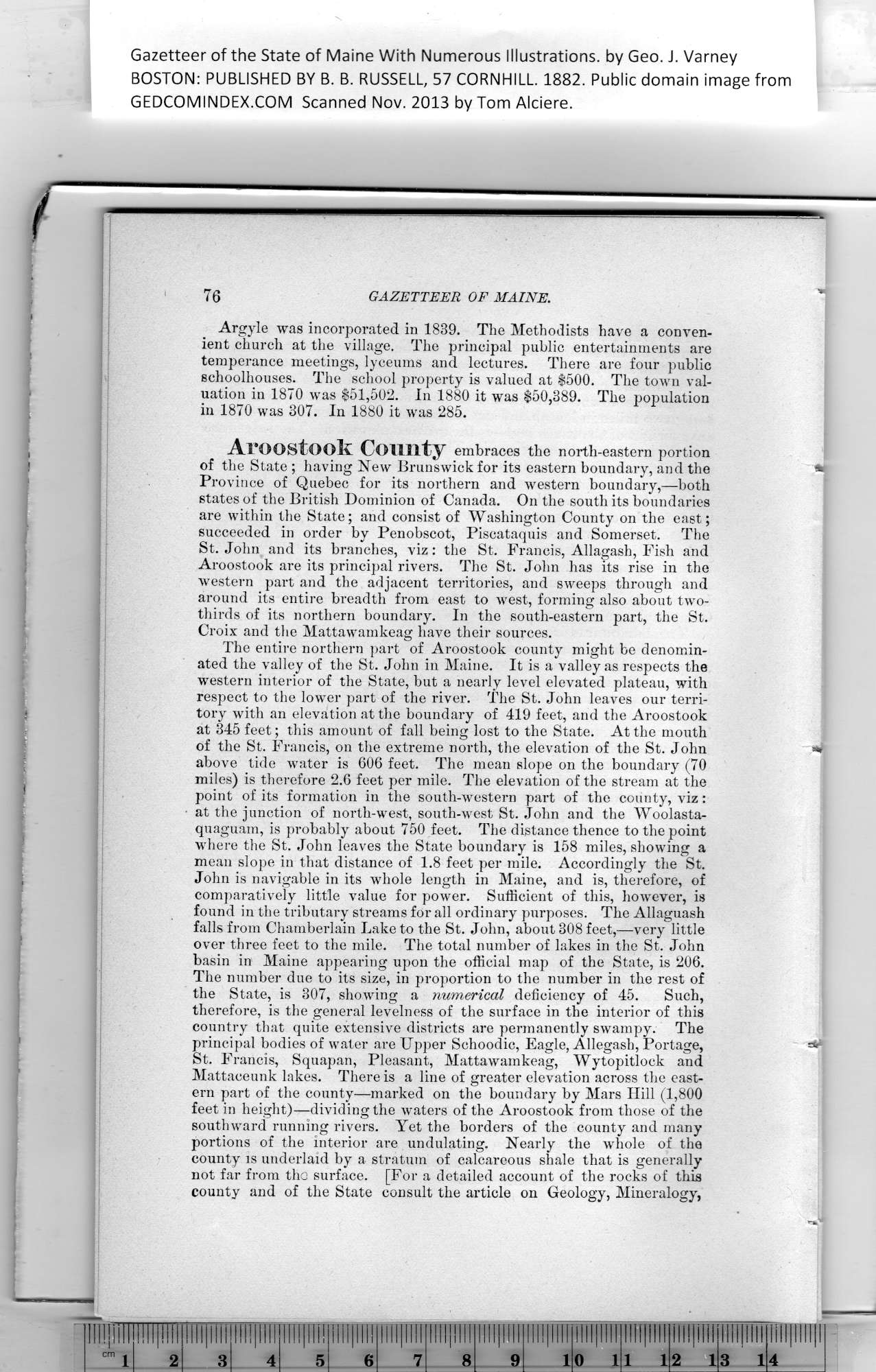|
Gazetteer of the State of Maine With Numerous Illustrations, by Geo. J. Varney
BOSTON: PUBLISHED BY B. B. RUSSELL, 57 CORNHILL. 1882. Public domain image from
76 GAZETTEER OF MAINE.
Argyle was incorporated in 1839. The Methodists have a conven-
ient church at the village. The principal public entertainments are
temperance meetings, lyceums and lectures. There are four public
schoolhouses. The school property is valued at $500. The town val-
uation in 1870 was $51,502. In 1880 it was $50,389. The population
in 1870 was 307. In 1880 it was 285.
Aroostook County embraces the north-eastern portion
of the State ; having New Brunswick for its eastern boundary, and the
Province of Quebec for its northern and western boundary,—both
states of the British Dominion of Canada. On the south its boundaries
are within the State; and consist of Washington County on the east;
succeeded in order by Penobscot, Piscataquis and Somerset. The
St. John and its branches, viz: the St. Francis, Allagash, Fish and
Aroostook are its principal rivers. The St. John has its rise in the
western part and the adjacent territories, and sweeps through and
around its entire breadth from east to west, forming also about two-
thirds of its northern boundary. In the south-eastern part, the St.
Croix and the Mattawamkeag have their sources.
The entire northern part of Aroostook county might be denomin-
ated the valley of the St. John in Maine. It is a valley as respects the
western interior of the State, but a nearly level elevated plateau, with
respect to the lower part of the river. The St. John leaves our terri-
tory with an elevation at the boundary of 419 feet, and the Aroostook
at 345 feet; this amount of fall being lost to the State. At the mouth
of the St. Francis, on the extreme north, the elevation of the St. John
above tide water is 606 feet. The mean slope on the boundary (70
miles) is therefore 2.6 feet per mile. The elevation of the stream at the
point of its formation in the south-western part of the county, viz:
at the junction of north-west, south-west St. John and the Woolasta-
quaguam, is probably about 750 feet. The distance thence to the point
where the St. John leaves the State boundary is 158 miles, showing a
mean slope in that distance of 1.8 feet per mile. Accordingly the St.
John is navigable in its whole length in Maine, and is, therefore, of
comparatively little value for power. Sufficient of this, however, is
found in the tributary streams for all ordinary purposes. The Allaguash
falls from Chamberlain Lake to the St. John, about 308 feet,—very little
over three feet to the mile. The total number of lakes in the St. John
basin in Maine appearing upon the official map of the State, is 206.
The number due to its size, in proportion to the number in the rest of
the State, is 307, showing a numerical deficiency of 45. Such,
therefore, is the general levelness of the surface in the interior of this
country that quite extensive districts are permanently swampy. The
principal bodies of water are Upper Schoodic, Eagle, Allegash, Portage, =*-
St. Francis, Squapan, Pleasant, Mattawamkeag, Wytopitlock and
Mattaceunk lakes. There is a line of greater elevation across the east-
ern part of the county—marked on the boundary by Mars Hill (1,800
feet in height)—dividing the waters of the Aroostook from those of the
southward running rivers. Yet the borders of the county and many
portions of the interior are undulating. Nearly the whole of the
county is underlaid by a stratum of calcareous shale that is generally
not far from the surface. [For a detailed account of the rocks of this
county and of the State consult the article on Geology, Mineralogy,
PREVIOUS PAGE ... NEXT PAGE
This page was written in HTML using a program written in Python 3.2
|
